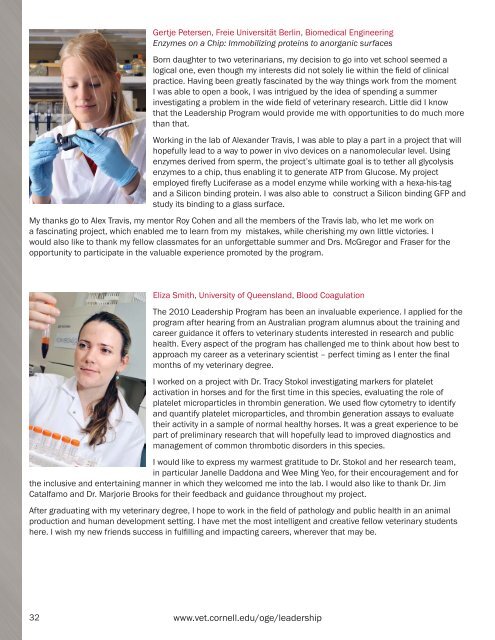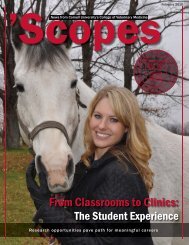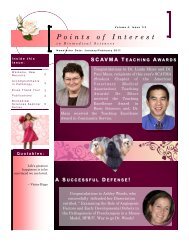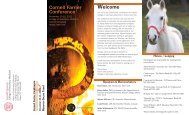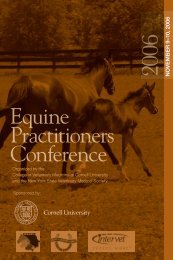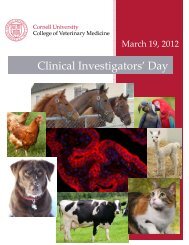2010 (PDF) - The College of Veterinary Medicine at Cornell University
2010 (PDF) - The College of Veterinary Medicine at Cornell University
2010 (PDF) - The College of Veterinary Medicine at Cornell University
You also want an ePaper? Increase the reach of your titles
YUMPU automatically turns print PDFs into web optimized ePapers that Google loves.
Gertje Petersen, Freie Universität Berlin, Biomedical Engineering<br />
Enzymes on a Chip: Immobilizing proteins to anorganic surfaces<br />
Born daughter to two veterinarians, my decision to go into vet school seemed a<br />
logical one, even though my interests did not solely lie within the fi eld <strong>of</strong> clinical<br />
practice. Having been gre<strong>at</strong>ly fascin<strong>at</strong>ed by the way things work from the moment<br />
I was able to open a book, I was intrigued by the idea <strong>of</strong> spending a summer<br />
investig<strong>at</strong>ing a problem in the wide fi eld <strong>of</strong> veterinary research. Little did I know<br />
th<strong>at</strong> the Leadership Program would provide me with opportunities to do much more<br />
than th<strong>at</strong>.<br />
Working in the lab <strong>of</strong> Alexander Travis, I was able to play a part in a project th<strong>at</strong> will<br />
hopefully lead to a way to power in vivo devices on a nanomolecular level. Using<br />
enzymes derived from sperm, the project’s ultim<strong>at</strong>e goal is to tether all glycolysis<br />
enzymes to a chip, thus enabling it to gener<strong>at</strong>e ATP from Glucose. My project<br />
employed fi refl y Luciferase as a model enzyme while working with a hexa-his-tag<br />
and a Silicon binding protein. I was also able to construct a Silicon binding GFP and<br />
study its binding to a glass surface.<br />
My thanks go to Alex Travis, my mentor Roy Cohen and all the members <strong>of</strong> the Travis lab, who let me work on<br />
a fascin<strong>at</strong>ing project, which enabled me to learn from my mistakes, while cherishing my own little victories. I<br />
would also like to thank my fellow classm<strong>at</strong>es for an unforgettable summer and Drs. McGregor and Fraser for the<br />
opportunity to particip<strong>at</strong>e in the valuable experience promoted by the program.<br />
Eliza Smith, <strong>University</strong> <strong>of</strong> Queensland, Blood Coagul<strong>at</strong>ion<br />
<strong>The</strong> <strong>2010</strong> Leadership Program has been an invaluable experience. I applied for the<br />
program after hearing from an Australian program alumnus about the training and<br />
career guidance it <strong>of</strong>fers to veterinary students interested in research and public<br />
health. Every aspect <strong>of</strong> the program has challenged me to think about how best to<br />
approach my career as a veterinary scientist – perfect timing as I enter the fi nal<br />
months <strong>of</strong> my veterinary degree.<br />
I worked on a project with Dr. Tracy Stokol investig<strong>at</strong>ing markers for pl<strong>at</strong>elet<br />
activ<strong>at</strong>ion in horses and for the fi rst time in this species, evalu<strong>at</strong>ing the role <strong>of</strong><br />
pl<strong>at</strong>elet microparticles in thrombin gener<strong>at</strong>ion. We used fl ow cytometry to identify<br />
and quantify pl<strong>at</strong>elet microparticles, and thrombin gener<strong>at</strong>ion assays to evalu<strong>at</strong>e<br />
their activity in a sample <strong>of</strong> normal healthy horses. It was a gre<strong>at</strong> experience to be<br />
part <strong>of</strong> preliminary research th<strong>at</strong> will hopefully lead to improved diagnostics and<br />
management <strong>of</strong> common thrombotic disorders in this species.<br />
I would like to express my warmest gr<strong>at</strong>itude to Dr. Stokol and her research team,<br />
in particular Janelle Daddona and Wee Ming Yeo, for their encouragement and for<br />
the inclusive and entertaining manner in which they welcomed me into the lab. I would also like to thank Dr. Jim<br />
C<strong>at</strong>alfamo and Dr. Marjorie Brooks for their feedback and guidance throughout my project.<br />
After gradu<strong>at</strong>ing with my veterinary degree, I hope to work in the fi eld <strong>of</strong> p<strong>at</strong>hology and public health in an animal<br />
production and human development setting. I have met the most intelligent and cre<strong>at</strong>ive fellow veterinary students<br />
here. I wish my new friends success in fulfi lling and impacting careers, wherever th<strong>at</strong> may be.<br />
32 www.vet.cornell.edu/oge/leadership


